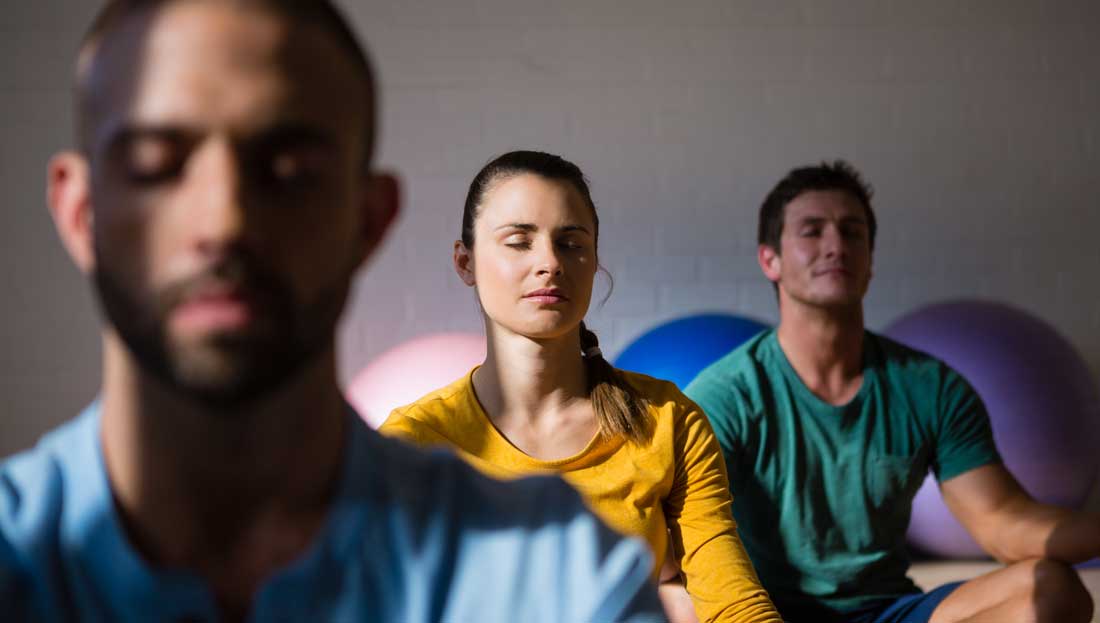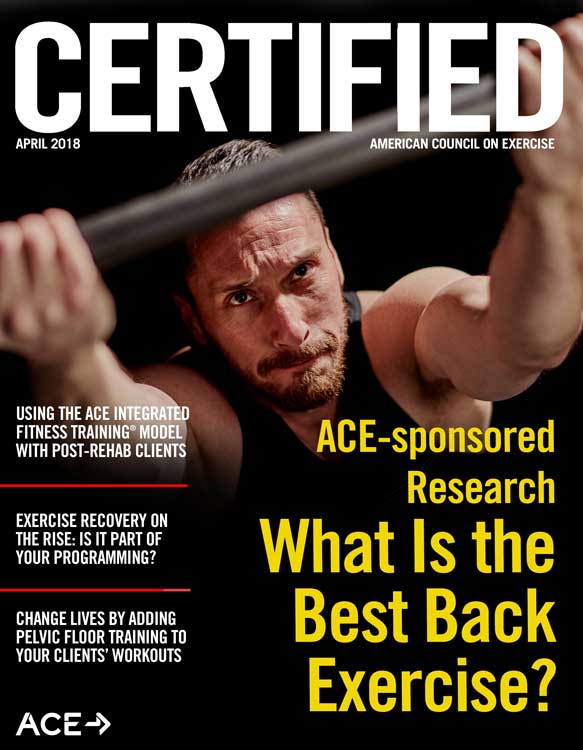
Professional athletes do it. Business executives do it. Military special operators do it. In recent years, high performers in a number of different fields have all begun participating in the same practice: meditation. For many, this word conjures images of a room full of yoga enthusiasts sitting quietly in awkward positions or a group of spiritual practitioners chanting in rhythm. Certainly not an executive in a power suit or a soldier outfitted with weapons of war. While meditation plays an important role in many religious practices and is often an integral component of yoga, could it also have a place in a well-rounded exercise program? More specifically, could meditation play a role in helping clients and group fitness participants achieve results or, at the very least, help enhance the overall exercise experience?
Understanding Meditation
For centuries, meditation has played an important role in many religious rituals, and it remains a component of many spiritual practices. Today, with the ability to measure brain waves, modern science offers insight into the specific physiological benefits of meditation, which has helped promote the practice outside of the traditional settings.
First, it’s important to understand what meditation is as well as what it is not. Here’s how Assistant Professor of Integrative Wellness at Point Loma Nazarene University and 2017 IDEA Group Fitness Instructor of the Year (for yoga) Jessica Matthews describes meditation: “[It’s] the ability to quiet the mind in order to let go of distracting thoughts and focus attention on the immediate moment.”
The practice of meditation is often considered a component of yoga, which has been classified as a mind-body format of exercise. This strikes Matthews as funny, because she asserts “any form of exercise is a mind-body exercise. If we are moving, we need to concentrate on what we are doing so we can move with purpose and intention.” In other words, from a technical point of view, any type of physical activity can qualify as a “mind-body” exercise.
Unlike other modes of exercise, however, where form or technique can make a difference in the outcome, there is no single way to meditate. Successful meditation simply requires the ability to breathe deeply, slow down and bring awareness to the present moment.
This means that meditation doesn’t need to happen from a specific posture or body position. In fact, meditation can occur when the body is moving.
“My approach is to practice meditation through movement,” explains Violet Zaki, an ACE Certified Group Fitness Instructor who uses meditation in the Zen Combat classes she teaches for Equinox in New York City. She echoes Matthews' belief that all movement requires a mind-body connection, “especially in martial arts where the movements have to be precise and students work to perfect their skills. At the beginning of class, I ask students to clear their minds of distracting thoughts so they can be present and focus on their movements for the next hour. One of my goals with class is to help participants develop a mind-body connection through movement.”
Benefits of Meditation
If meditation sounds like something best left in a yoga studio, it might be necessary to remove that bias and reconsider meditation from a different point of view.
Think of the brain as a muscle and meditation as the perfect form of exercise to make it stronger. You undoubtedly encourage your clients to lift weights to make their muscles stronger, or advise them to do cardio exercise to improve their heart’s ability to pump blood through the body. So why not learn more about meditation and how to practice it so you can help your clients improve the strength of the muscle between their ears? A wide range of health and exercise professionals have recognized the benefits of meditation and have developed different strategies for encouraging clients to meditate as a component of exercise.
“When working with clients, I practice what I refer to as mindful moving meditation,” says Sherian Lee, a licensed psychotherapist, ACE Certified Personal Trainer and Group Fitness Instructor, and owner of Best Self, a therapy clinic in Cupertino, Calif. “ I ask [clients] to focus on targeting their muscles through conscious thoughts and how different exercises effect the muscles being used. Having an open, nonjudgmental mind helps my clients focus on the exercises, helping them to really experience the workout on a much deeper level.”
Because the fundamental purpose of meditation is to bring awareness to what you are doing and how you are feeling in a specific moment, there are many ways that it can be used during a training session. Juan Carlos Santana is owner of the Institute of Human Performance in Boca Raton, Fla., and a strength coach who works with clients ranging from professional mixed martial arts athletes preparing for a title fight to older adults who want to remain active through their golden years. He believes that meditation is essential in a fitness program and practices a unique approach that he calls Present Moment Awareness (PMA) with his clients.
“I encourage my clients to be present in the moment so they can improve their performance by concentrating on whatever task is challenging them at that moment,” explains Santana. “In my experience, people will quit a physical challenge based on what they fear will happen, which is projecting into the future as opposed to what is actually happening in the present—the now.”
Santana also encourages his clients to relax their faces during workouts. “Learning how to remove the grimace when doing hard exercise is the first step toward learning how to be present in the moment,” he says. “If we can help our clients learn how to be comfortable when things get hard, we will be giving them skills that can be used in all aspects of their lives, not just during a workout.”
Likewise, group fitness instructors can identify various ways to encourage class participants to incorporate meditation in their exercise programs. Clifton Harski, fitness director and co-owner of the Fit Wall fitness studio, advocates using meditation in the group programs that he coaches.
“Meditation asks that you empty your mind and focus on breathing,” explains Harski. “At the beginning of the workout, I encourage my class participants to empty their minds so they can focus on the physical tasks at hand. I want them to focus on the process of learning movement, which in itself can be a form of meditation.”
What Does the Research Say About the Benefits of Meditation?
A meta-analysis of the existing research on meditation suggests that the practice does indeed produce quantifiable benefits. One comprehensive review of the literature identified two main findings: (1) Meditation has a substantial impact on psychological variables; and (2) Its effects might be somewhat stronger for negative emotional, as opposed to cognitive, variables (Sedlmeier et al., 2012).
Additional recognized benefits of meditation include:
- Enhanced concentration
- Reduced stress
- Less anxiety
- Enhanced feelings of calmness
- Greater mental clarity
As mentioned, science is now able to measure exactly how meditation influences the brain. One significant benefit that has been identified is meditation’s effect on the medial prefrontal cortex of the brain—the part that processes information relating specifically to the self and is often referred to as the “Me Center.” When stress accumulates, it can influence this part of the brain and lead to the perception that things are happening directly to you on purpose, which can subsequently increase feelings of anxiety. Meditation can help reduce this activity in the medial prefrontal cortex, while increasing activity in the lateral prefrontal cortex. This is the part of the brain that considers incoming information from a more logical perspective and is often referred to as the “Assessment Center.” Regular meditation can reduce activity in the Me Center while engaging the Assessment Center, thus helping to control anxiety and allowing events to be perceived from a more rational, objective point of view (Gladding, 2013).
Chad Yarvitz is owner of the Xplicit Fitness, co-founder of Implicit Cycling studios in San Diego and a master trainer for Matrix Fitness. He says his meditation practice has long played an important role in both his career as a competitive athlete and in life in general.
“Meditation was a huge part of my boxing career,” says Yarvitz. “Walking into new gyms and venues to spar or fight could be very stressful, which took my focus off of what I was there for—which is not a good thing in the sport. As I studied and learned about the power of positive thought, power phrases and meditation, and then applied those principles, it didn’t just change my career. It molded my way of thinking and approach to everyday life.”
Adding Meditation to Your Fitness Toolbox
In this modern era, multitasking and constantly checking social media for status updates or likes has made the ability to simply sit and be quiet something of a lost skill. Whether you’re in line at the local coffee shop or waiting for the class ahead of yours to be over, what do you do when you find yourself waiting for more than a few moments? If you’re like most people, you probably whip out your phone and start tapping the screen.
According to Matthews, small moments like these are perfect opportunities for a brief meditation. No stranger to a full and hectic schedule, Matthews looks for little moments throughout the day when she can meditate. “While I do make an effort to set aside specific time for meditation, I have found that sometimes just taking or moment or two to breathe deeply and focus on being still can have a profound effect and really change the way I am feeling.”
And that, in short, is the heart of meditation. It’s the ability to take a break from the chaos of daily life to be still and focus inwardly for a moment. As a health and exercise professional, you undoubtedly experience a wide range of demands on your time and expertise, which can drain your energy and make it challenging to be present for your clients and participants. The next time you have a moment to yourself, no matter where you are, rather than check your social media feed, take the opportunity to pause, breathe deeply and allow your mind to be still. As is the case with any other form of exercise, the more you practice it, the more you will be able to coach others on how to add meditation to their daily routines.
Here are some simple tips for practicing meditation. Try these yourself and as you find what works, feel free to share with your clients and classes (Valley Health System, 2017):
- Pay close attention to your breathing.
- Notice what you’re sensing in a given moment—the sights, sounds and smells that ordinarily slip by without reaching your conscious awareness.
- Tune into physical sensations, from your posture to the way that the air is circulating around your body. Focus inward to really notice what your body is feeling in that moment.
“Extra work in the studio can help you accomplish extra work in your life,” says Zaki. “Students tell me that they carry what we practice in the studio to other aspects of their lives, which can be some of the most rewarding feedback a group instructor can hear.”
References
Gladding, R. (2013). This Is Your Brain on Meditation.
Sedlmeier, J et al. (2012). The psychological effects of meditation: A meta-analysis. Journal of the American Psychological Association, 138, 6, 1139-1171.
Valley Health System (2017). What Is Mindfulness-based Meditation and Why Should I Try It?





 by
by 


